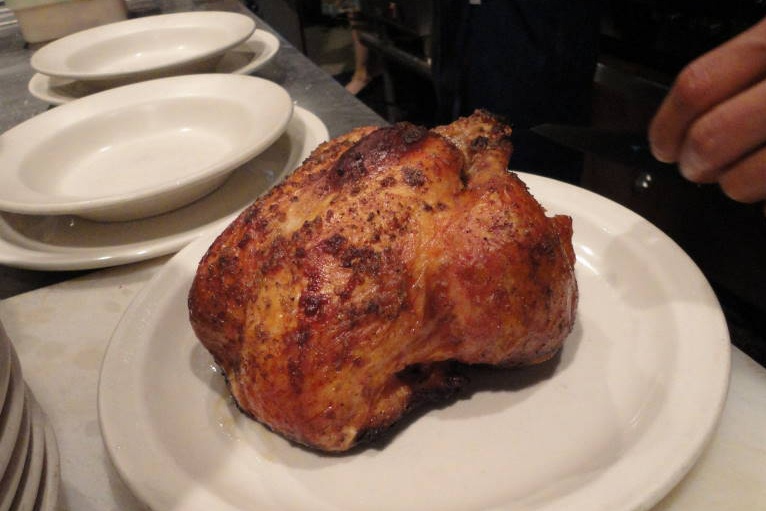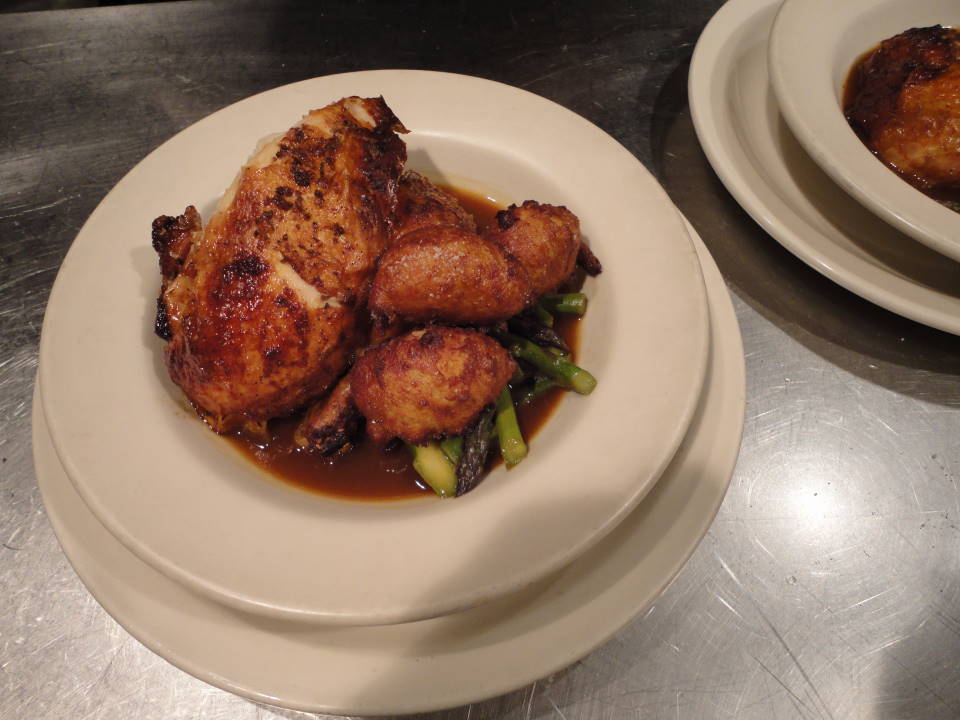
I was recently asked by Seattle DINING if I would give up the recipe for the Whole Roasted Chicken for two that we serve at Le Pichet and Cafe Presse, to be featured in their “Chef’s Kitchen” section. I agreed (the feature is scheduled to appear on their website beginning sometime in July 2011) and, as I was putting together some notes about this recipe, I thought maybe they would be of interest here as well.
In general, I am not very sticky about giving out the recipes for the dishes we cook at the restaurants. This is mostly because, as a chef who specializes in the traditional dishes of France, lets face it, I didn’t invent most of the dished that we serve. Some were not well know before we featured them, but the germ of the idea, at least, for most of our dishes comes from traditional regional French dished that I have tried or read about. We do often use a few tricks or methods that are not completely traditional, but in general, my approach to developing a recipe is to go to the traditional method, paying special attention to be sure that all the little details are respected.
Our roasted chicken is a different story. This is because the traditional method of roasting a chicken just doesn’t work with the time line of most American diners. If you look at Escoffier to find the traditional method of roasting a whole chicken, you will find that the chicken is trussed, then often stuffed with herbs and basted with butter before going into a medium oven in a heavy pan. During the roasting, the bird is moved so that first one side, then the other and finally the breast is in contact with the pan so that the final result is an evenly golden brown bird. The total roasting time is between 1 1/4 hour and 1 3/2 hours depending on the size of the chicken.
This method works well enough if you are roasting a chicken at home and time is not an issue, or if your guests are counting on a four hour dinner, as was the case when Escoffier was cooking at the Ritz in Paris. Admittedly, it generally gives a bird with a less crispy skin that I would like, but a very flavorful bird none the less. In a restaurant, however, asking guests to wait 90 minutes or even 75 minutes for their main course is just not an option. So what are the other choices? Well, generally there are a couple:
1) Split the bird in half and roast it. This is much faster, with the cooking being completed in as little as 30 minutes, but the loss of juices due to the cutting is a big drawback. End result: dry bird. Another variation on this is to roast or saute only the breast, but if you are hoping for a whole, beautiful, crispy bird, this just doesn’t satisfy.
2) Par cook the chicken, meaning that you partially (or fully) cook the bird in advance, then finish the cooking (or reheat the fully cooked bird) to order. The problem with the partial cooking is that the skin doesn’t get crispy, not to mention that there are sanitation issues with partially heating a chicken to less than 160 deg F and then cooling it (it is basically a big bacteria incubator). On the other hand, cooking the chicken to 160 degrees and then cooling it, then reheating it, this is basically the recipe for a really dry bird.
3) Keep a few birds roasting all the time as is done at some rotisseries and just serve the bird that is ready when it is ordered by the guest. In theory this works, but only if the finished birds are ordered as soon as they are ready and not before or after. More likely, the finished birds either sit and get dry or the guest waits too long for one to finish.
No, the only solution is to find a way to roast a chicken to order that takes an hour or less. In the year before the opening of Le Pichet in 2000, I roasted a lot of chickens, trying to figure out the best way to do this. I finally hit on a method that gives a really tasty, crispy bird in about 55 minutes so that we can have it on the table one hour after it is ordered. The idea is to truss the bird, baste it with butter, sprinkle with course sea salt and then roast in a very hot oven. That’s the whole deal; couldn’t be easier. Auguste Escoffier might not approve but it is the best bird I have ever cooked, regardless of method used. Check out the recipe page for details.

This is the final result as it is served at Le Pichet. Or at least it was served until July 8, 2011. We started a new menu on July 9, so the roasted chicken is now served with a warm salad of flageolet beans tossed with sweet corn, bacon, scallions, bleu cheese and a white vermouth vinaigrette.
Hi Jim,
We’re new yorkers who were lucky enough to get directed to your restaurant by the chef at Steelhead. Although by the time we arrived we were too hungry to try your chicken(which I would have loved to do since I too am always looking for a tasty, relativly quick roast chicken), I did have your tomato soup with bacon and thought it was just fantastic!. The waitress suggested I write to you and that you might be willing to share it with me; I hope she was right. Thank you in advance ! We returned to NY tonight 7/25 but just missed your interview on the Food network.
Regarding the new preparation. Is the bleu cheese you use made from pasteurized milk? My wife is expecting and she’s supposed to stay clear of unpasteurized cheeses. We really love the roasted chicken at Le Pichet and would hate to have to skip it (even for 9 months)!
The Forme d’Ambert bleu cheese we use for this preparation is made from raw milk. However, we could certainly leave it our of your wife’s portion (we could even send it out on the side so that you can eat it yourself…unless you are giving up raw milk cheeses in sympathy!). Jim